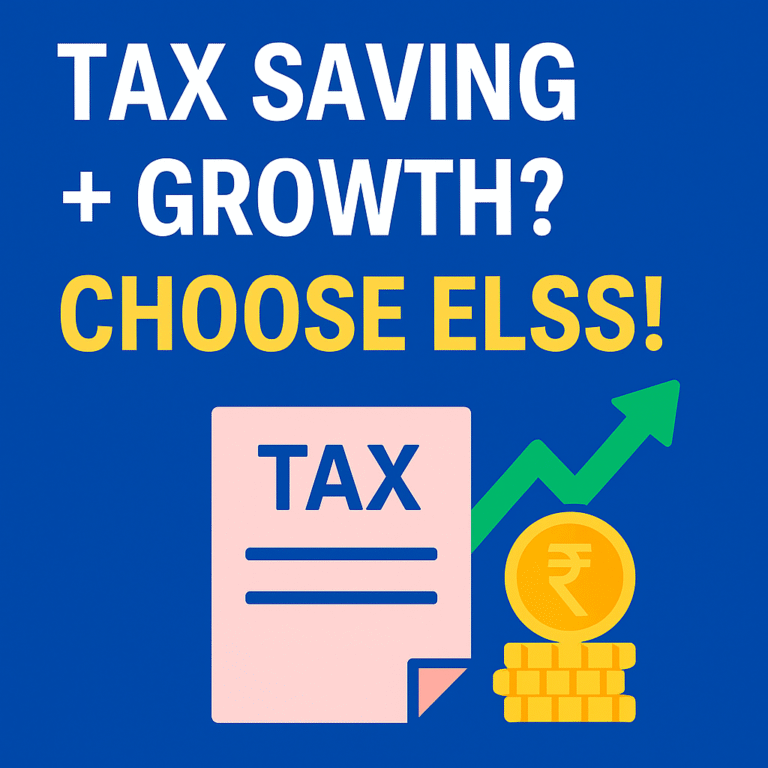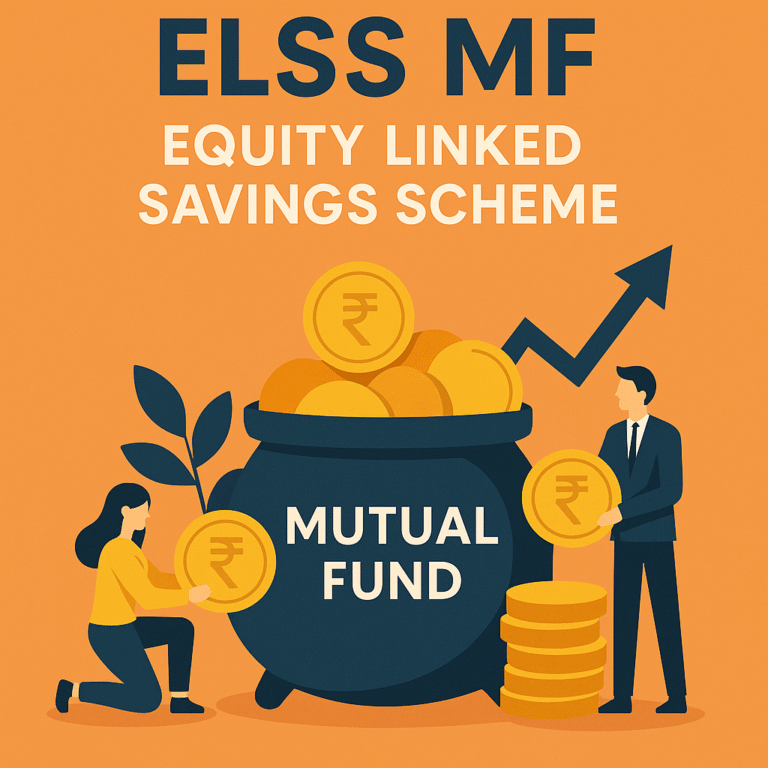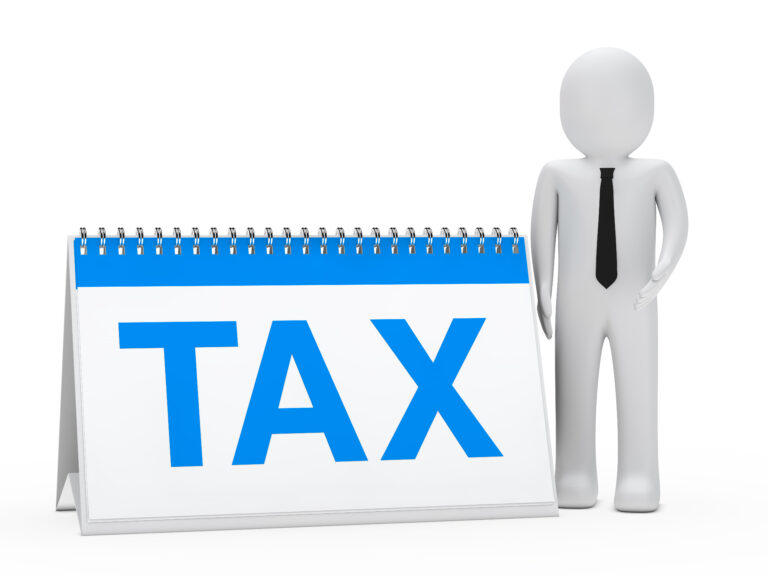Introduction – Why Tax Planning & Wealth Creation Go Hand in Hand
Every January to March, millions of Indians suddenly remember something important — tax planning. The rush to invest before 31st March feels like a last-minute exam preparation. People start scrambling for LIC policies, random tax-saving FDs, or insurance plans that promise tax deductions.
I’ve been there too. In my early banking career, I often bought products only to save tax, without even thinking whether they were building wealth for me. But over time, as I transitioned into wealth management, I realized something powerful: smart tax saving is not about avoiding tax once a year — it’s about combining tax benefits with long-term wealth creation.
And that’s exactly where ELSS Funds (Equity Linked Savings Scheme) come in.
In this blog, I’ll share not only what ELSS funds are, but also how they work, why they are better than traditional tax-saving products, their risks, and how I personally approach them with clients.
Table of Contents
Chapter 1: What Exactly Are ELSS Funds?
Let’s keep it simple.
ELSS = Equity Mutual Fund + Tax Benefit under Section 80C.
That means:
You invest in an equity mutual fund (your money goes into stocks).
You get up to ₹1.5 lakh deduction under Section 80C of the Income Tax Act.
Your investment comes with a lock-in of 3 years (lowest among all 80C options).
In short:
Save tax ✅
Build wealth through equity ✅
Shortest lock-in ✅
This makes ELSS one of the most efficient tax-saving options in India.

Chapter 2: Why I Recommend ELSS Over Traditional Options
In banking, I often saw people rush to buy tax-saving FDs or insurance policies. Yes, they give deductions, but their returns were too low to beat inflation.
Let’s compare:
| Investment Option | Lock-in | Expected Returns | Tax Treatment |
|---|---|---|---|
| ELSS Funds | 3 years | 10–12% (long term) | Gains taxed as LTCG (10% over ₹1L) |
| Tax-Saving FD | 5 years | 5–6% | Fully taxable |
| PPF | 15 years | 7–8% | Tax-free |
| Life Insurance (Traditional) | 5–20 years | 4–6% | Tax-free (with conditions) |
| NPS | Till 60 yrs | 8–10% | Tax benefits, but withdrawal restrictions |
Clearly, ELSS gives the best combination of wealth creation + tax saving + flexibility.
For a young professional, the 3-year lock-in is manageable. For long-term wealth creation, ELSS is a gateway to disciplined equity investing.
Chapter 3: How ELSS Works – The Mechanism
ELSS is nothing mysterious. It’s just like a regular equity mutual fund, but with one additional benefit (tax saving).
You can invest lumpsum (say ₹1.5 lakh at once).
Or through SIP (Systematic Investment Plan).
The money is invested in equity markets across large-cap, mid-cap, and sometimes small-cap stocks.
After 3 years, you can redeem it, or stay invested for longer.
Pro Tip from My Practice: I always encourage clients to use SIP in ELSS. Why? Because:
You don’t feel the pinch of investing ₹1.5 lakh at once.
SIPs help average out market volatility.
Over the years, it creates a habit of investing for both tax and wealth.

Chapter 4: Why the 3-Year Lock-In is a Blessing in Disguise
Most people see the 3-year lock-in as a restriction. But here’s the truth:
It’s actually a discipline tool.
If ELSS were as liquid as regular equity funds, many investors would redeem during the first market fall. But because you are “locked in,” you are forced to stay invested.
And if you look at history, Indian equity markets have rewarded patient investors:
3-year returns can be volatile.
5+ year returns smoothen out.
10-year returns have consistently beaten inflation and FDs.
By “forcing” you to hold for 3 years, ELSS helps you stay invested long enough to see equity magic work.
Chapter 5: The Risk Factor – Don’t Ignore This
Let’s be real. ELSS is not risk-free.
Since ELSS is an equity fund, its returns depend on the stock market.
If markets fall, your ELSS value can fall too.
Unlike PPF or FD, returns are not guaranteed.
But here’s my perspective:
When you are saving tax under Section 80C, you have to choose something. You can either:
Play it safe with FD/PPF and barely beat inflation.
Or take calculated equity risk through ELSS, with the potential to double wealth over 10–15 years.
For young professionals especially, time is on your side. Market ups and downs don’t matter much if you are consistent.
Chapter 6: My Personal Experience with ELSS
When I started investing in ELSS, I remember putting in my first ₹5,000 SIP just to “try it out.” At the time, my primary motivation was tax saving.
But here’s what happened:
Within 3 years, the money grew beyond my expectations.
More importantly, I realized I could use tax season not as a stress point, but as a chance to build wealth.
Today, I guide my clients the same way: “Don’t invest in ELSS only to save tax. Invest to create long-term wealth, and let tax saving be the cherry on top.”
I’ve had clients who started SIPs of ₹5,000/month in ELSS 7–8 years ago. Many of them now have portfolios worth several lakhs — all while enjoying tax deductions every year.
That’s the beauty of ELSS: It rewards patience, discipline, and consistency.
Chapter 7: Taxation of ELSS – What You Must Know
ELSS gives you tax benefits under Section 80C. But what about the returns?
Tax Saving: Up to ₹1.5 lakh investment eligible under Section 80C.
Returns: Classified as Long-Term Capital Gains (LTCG).
LTCG on equity is tax-free up to ₹1 lakh per year.
Above ₹1 lakh, taxed at 10% without indexation.
Example:
You invested ₹1.5 lakh.
After 3 years, it became ₹2.1 lakh.
Gain = ₹60,000.
Since it’s under ₹1 lakh, no tax on gains.
So not only do you save tax while investing, but your returns are also tax-efficient compared to FD interest (which is fully taxable).

Chapter 8: Who Should Invest in ELSS?
Perfect for:
Young professionals starting careers.
Salaried employees who want both tax savings and equity exposure.
Investors with long-term goals like retirement, children’s education, or wealth creation.
Not ideal for:
Someone looking for guaranteed returns.
Those with very short-term goals (<3 years).
People uncomfortable with market volatility.
Chapter 9: How to Choose the Right ELSS Fund
There are 40+ ELSS funds in India. How do you pick one?
Here’s my checklist (which I use with clients):
Track Record: Look for funds with consistent 5–10 year performance.
Fund House Reputation: Stick to reputed AMCs (HDFC, ICICI, Axis, SBI, Mirae).
Expense Ratio: Lower the better, as it affects long-term returns.
Portfolio Style: Some ELSS funds are large-cap focused, others are multi-cap. Choose based on your risk profile.
SIP Friendly: Ensure the fund allows SIP for disciplined investing.
Chapter 10: ELSS vs Other Tax-Saving Investments
I often get this question: “Should I put money in PPF, FD, or ELSS?”
Here’s how I answer:
If your goal is wealth creation + tax saving, go for ELSS.
If you want safe but long-term locked returns, choose PPF.
If you are risk-averse and want guaranteed but low returns, FD/NSC may suit you.
In fact, I usually advise clients to balance — have some PPF (safe, long-term) and some ELSS (growth, equity). This way, you have both security and growth.
Chapter 11: Action Plan – How to Get Started
Check your 80C limit. If you haven’t used ₹1.5 lakh fully, ELSS is a smart option.
Choose 1–2 good ELSS funds. Don’t spread across too many.
Start SIP. Even ₹3,000–₹5,000/month makes a big difference.
Stay invested. Don’t redeem just because the market falls after 3 years.
Review annually. Ensure your fund is performing well compared to category average.
Conclusion – More Than Just Tax Saving
ELSS is often marketed as a “tax-saving product,” but to me, it’s more than that. It’s an entry point into the world of equity investing for millions of Indians.
Yes, you save tax. But more importantly, you:
Build long-term wealth.
Learn the discipline of SIPs.
Stay invested through a lock-in.
Benefit from equity markets over decades.
If you’re serious about both reducing your tax burden and creating wealth for your future, ELSS deserves a place in your portfolio.
Don’t wait for March 31st. Start now, stay consistent, and let compounding and tax savings work in your favor.




